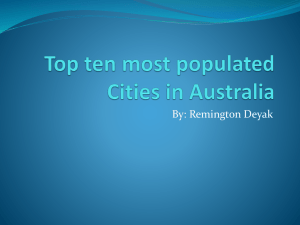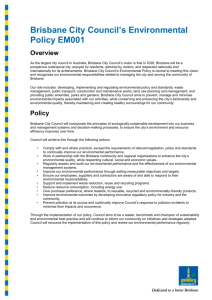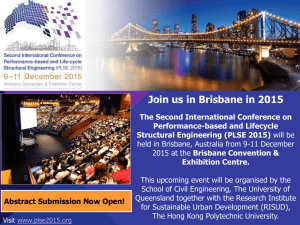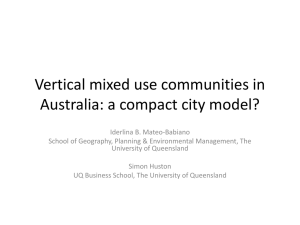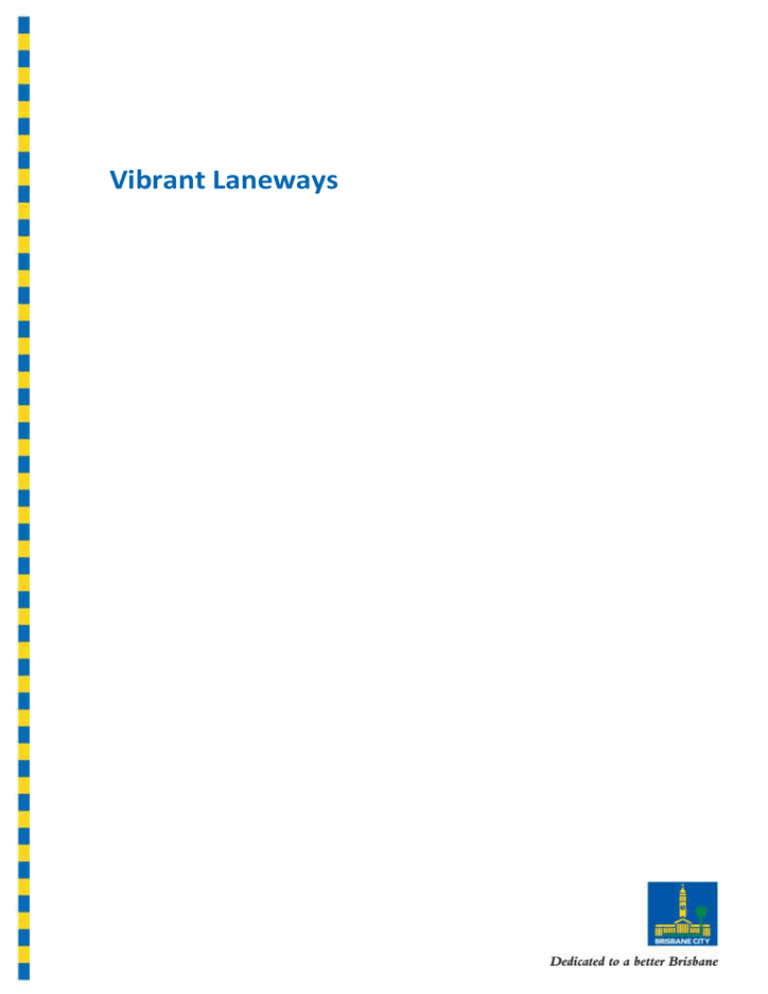
Vibrant Laneways
Vibrant Laneways art program
Brisbane City Council’s Vibrant Laneways program supports activation of laneways,
arcades and alleyways to deliver a new dimension to the Brisbane city centre. A
sense of discovery experienced through interacting with the hidden fabric provides
rich and engaging pedestrian, retail and commercial experiences.
The Vibrant Laneways art program offers incidental cultural experiences in the city. It
seeks to attract visitors to explore forgotten laneways and contemporary artworks,
encouraging revitalisation of these spaces, contributing to our vision of Brisbane as
Australia’s new world city.
It’s easy to forget that Burnett Lane, with its frontage to Queen Street, was the original site
for official buildings related to convicts: the residence of the Superintendent of Convicts,
prisoners' cells and the prisoners' barracks. Archaeologists have determined that Burnett
Lane is paved over the prisoners’ barracks yard. After the penal settlement closed, Burnett
Lane also housed the city’s first town hall until the current Brisbane City Hall opened in 1930.
Little evidence remains.
Centred on an idea of the past in the present, the Vibrant Laneways art program has invited
contemporary artists to present temporary artworks across Hutton, Eagle, Edison and
Burnett Lanes. Given the histories of many of Brisbane’s laneways, the commissioning
program has sought to connect with, and draw upon, the histories of these sites to introduce
richness and depth into presently muted public spaces.
History has often been a popular subject for public art commissions. As contemporary art is
popularly thought of as breaking with the past, it may seem incongruous to invite
contemporary artists to rummage history. Contemporary art, however, is embedded in
history and tradition. Whether referencing the history of the site or another time and place the Renaissance, 18th century English anatomist and surgeon John Hunter, feminism or the
Pacific - these temporary commissions quote history and tradition.
As a curated group, the artworks may be described as bright, optical, even kaleidoscopic,
interesting, reflective and personal. Derived from the Ancient Greek terms meaning
’beautiful’, ‘that which is seen’ and ‘to look, or examine’, together a kaleidoscope is an
‘observer of beautiful forms.’ Like the refracted mirrors of a kaleidoscope, the commissioned
artworks offer a temporary interlude to see and examine the past and the future.
The past cohabits the present and informs the future. Memory, which has a nostalgic or
almost melancholy component presupposing a loss, is capable of bringing the past into the
present: a procedure that does not take place without interpretation and selection.
Undertaking a process of historical reflection, revision, the re-examination of existing
historical knowledge or the distortion of the historical record, or collective memories, so that
certain events may appear more or less favourable, is tied with responsibilities.
Through each temporary artwork, like the refracted mirrors of a kaleidoscope, we might
observe the past in the present expressed by the clash of cultures, ideas and materials. The
Vibrant Laneways art program offers an opportunity to examine how we consume images
and critique ideas within urban spaces. The city may be built by others but its meaning is
determined by our interactions with it.
Guided tours
The Brisbane Greeters program offer guided public art and cultural greets. Staffed by
passionate and knowledgeable volunteers, Brisbane Greeters provide insights into the
temporary laneway commissions, as well as contemporary and historic public artworks in
Brisbane city.
Public art and cultural greets are free and take approximately two to four hours, beginning at
the Brisbane Visitor Information and Booking Centre, located in the Queen Street Mall.
For further information or to book visit www.brisbanegreeters.com.au
Locations
Burnett Lane
LINCOLN AUSTIN Do you see what I see? 2014
June 2014 – June 2016
ROSS MANNING Through the Hologram 2013
May 2013 – June 2014
Hutton Lane
JACKIE RYAN Little Girl Lost 2014
October 2014 – January 2015
PAUL MUMME Slapstick 2014
April – September 2014
ALICE LANG The Swell 2012
September 2014 – January 2015
SAM TUPOU Future Primitive 2013
December 2013 – April 2014
ELIZABETH WILLING Lunch 2012
September – November 2013
KRISTI ARNOLD Grotesquerie 2012
March – August 2013
Edison Lane
MARTIN SMITH Revelation #7 2014
April 2014 – May 2015
REUBEN PATERSON Seek to Find to Yield 2013
April 2013 – April 2014
Eagle Lane
HIROMI TANGO Moon Jellies 2013, Magic 2013, Tears 2014 and Promised 2014
October 2014 – January 2015
TONY ALBERT Brothers 2014
April – September 2014
REKO RENNIE Trust the 2% 2013
September 2013 – April 2014
SUE KNEEBONE Things to Come 2013
June – August 2013
Rowes Lane
PETER LEWIS Gravity with Gravitas and Bar 2014
2014 (permanent installation)
Fish Lane
JOACHIM FROESE Hortus Conclusus 2014
June 2014 – January 2015
Map of section of Brisbane’s CBD highlighting locations for Vibrant Laneways art program –
Hutton Lane, Burnett Lane, Edison Lane, Eagle Lane and Fish Lane.
LINCOLN AUSTIN Do you see what I see? 2014
On arriving in Brisbane in 2000 one of my first tasks was to seek out art material suppliers.
Within weeks I found myself searching for a nondescript doorway on Burnett Lane, that door
led me into a ‘nowhere’ space with an elevator which took me up to Australian Jewellery
Supplies and a treasure trove of tools and materials. Back then Burnett Lane was lined with
delivery vehicles and garbage bins, it was a world of products and packaging. For this
reason I chose to employ a packaging material, hundreds of layers of cut corflute plastic, to
create these lanterns.
Image: LINCOLN AUSTIN Do you see what I see? 2014
ROSS MANNING Through the Hologram 2013
Through the Hologram is based on an optical phenomenon called Birefringence or Double
Refraction. Utilising the same materials used in flat screen televisions and other state-of-theart screen-based technologies such as 3D glasses, this effect is the result of two polarised
sheets with a clear polyester sheet sandwiched in-between. Light waves from the LEDs
become unidirectional as they pass through the polarised film. This light then hits the
polyester allowing different wavelengths through depending on the thickness, creating multicolours and patterns, which also change and pulse with the viewing angle.
Image: ROSS MANNING Through the Hologram 2013
JACKIE RYAN Little Girl Lost 2014
What would a person from yesteryear make of Brisbane city today? Would they feel like a
little girl lost? In this series the past collides with the present when a shepherdess of old
finds herself separated from her sheep in the modern Brisbane CBD. So what does our
shepherdess make of the present? It’s a little daunting at first, but there is a happy ending in
store when she and the sheep are reunited with a loving hug at the corner of Hutton Lane.
Image: JACKIE RYAN Little Girl Lost 2014
PAUL MUMME Slapstick 2014
The pain of others is amusing. This is encapsulated by the German term Schadenfreude,
which translates to ‘harm-joy’. In English it is better known as ‘slapstick’. Two ways to view
this phenomenon are that humans are innately cruel, or that we instinctively make light of
misfortune to make it more bearable. My work is inspired by the absurd contradictions of
human existence. In this series slapstick acts are repeatedly performed on the self to
exaggerate their violent capacity for humour and highlight the coexistence of these two
seemingly distinct ideas. It was quite painful. I hope you enjoy it.
Image: PAUL MUMME Slapstick 2014
ALICE LANG The Swell 2012
This series of text-based drawings explores the meaning, presence and experience of
feminism within the lives of Australian women in the past and present. The text within this
work is derived from a conversation between the artist and her mother about their different
experiences and perceptions of feminism, the effect that feminism has had in their lives and
how knowledge is passed between generations to inform and shape the future.
These personal reflections touch on the wider discussion of contemporary feminism and
sexism that is currently occurring within Australia, and a new wave of feminism, which is
slowly rippling out across the country.
Image: ALICE LANG The Swell 2012
SAM TUPOU Future Primitive 2013
Future Primitive investigates Pacific culture in a rapidly changing global environment. The
artwork touches on themes of migration, culture clash, decoration and value, with particular
focus on elements that unite the Pacific, such as recurring design motifs and traditional
patterning.
Within this work Tupou considers how imagery and patterns from our past can morph and
adapt, taking on new meaning, gaining whole new value systems through re-contextualising
and splicing with present day realities and future aspirations.
Image: SAM TUPOU Future Primitive 2013
ELIZABETH WILLING Lunch 2012
Elizabeth Willing’s works utilise food as a material for making art. To create these designs
she has used a potato printing technique, but has replaced the potato with foods associated
with a packed or takeaway lunch in the city. The lightboxes act like lunchboxes filled with
various foods considered both nourishment and/or indulgence. Willing is interested in the city
as a place where workers may eat a hurried lunch. The black line drawings prompt us to
remember that our hands play a significant part in eating and that our hands are
sophisticated tools for creating and consuming.
Image: ELIZABETH WILLING Lunch 2012
KRISTI ARNOLD Grotesquerie 2012
We typically associate the word grotesque with the horrific, the repulsive, the ugly and the
distorted. However, the grotesque once described an ornamental style of painting during the
Renaissance that embodied not the ugly, but the beautiful. Arnold’s work explores the history
of the grotesque, in conjunction with its original aesthetic, but also associates the grotesque
with flux, always in a state of transformation. In Arnold’s work, this is consistently expressed
through contrasting ideas and forms such as order/disorder, beauty/ugliness and
representation/abstraction. Leading to an alternative viewpoint of the term grotesque, Arnold
invites the viewer to perceive and create his or her own interpretations.
Image: KRISTI ARNOLD Grotesquerie 2012
MARTIN SMITH Revelation #7 2014
Revelation #7 explores the relationship between family photography, myth and reality and is
part of my ongoing series entitled Revelations. It presents the underlying insecurities, egos
and vanity of family life, normally masked and obscured by family photos. The images
presented in this series suggest the deficiencies of a father who is revealed as an object of
derision by his children for the inept decisions made by him about their lives. In Revelation
#7 the father’s cultural impositions upon his children suggest more to do with making him
seem culturally ‘in-touch’, than encouraging his children’s inherent cultural interests.
Image: MARTIN SMITH Revelation #7 2014
REUBEN PATERSON Seek to Find to Yield 2013
Thus the lover of universal life enters the crowd as though it were an immense reservoir of
electrical energy. Or we might liken him to a mirror as vast as the crowd itself; or to a
kaleidoscope with consciousness, responding to each one of its movements and producing
the multiplicity of life and the flickering grace of all elements of life.
- Charles Baudelaire
Baudelaire’s lover of life is the flâneur (or ‘stroller’), for whom the built environment of the
city, together with its flows of traffic and people, are understood as resources for the
construction of a text - the city may be built by others but its meaning is determined by our
interactions with it.
Reuben Paterson suggests that memory is also a kind of kaleidoscope, that the past
cohabits with and informs the present. Fragmenting our view of a forest river, the arcadian
past of our river city, he evokes the dynamic force of history passing through the landscape.
Negotiating our own refractory experiences and memories to bring interpretation to light, we
illuminate this image with meaning.
This is a critical social act because, as we evolve together with the artwork, it is we who
circulate this inspiration and knowledge; we are the coming of light into the world.
Ann Poulson
Image: REUBEN PATERSON Seek to Find to Yield 2013
HIROMI TANGO Moon Jellies 2013, Magic 2013,
Tears 2014 and Promised 2014
Hiromi Tango’s artworks develop organically from one project to the next, evolving according
to site requirements and possibilities of audience engagement. Her installations (and
performances) are based on collaborations between herself and others. Her works create a
critical dialogue that explores artist-public engagement, exploring how, by intervening into a
particular space, the artist can generate unexpected moments of intimacy and evasion, and
how fundamental aspects of human relations can contribute to an art-making process.
Through these interventions, Tango seeks to blur and re-integrate the boundaries between
conventional ways of relating. Her works address the paradoxical and unstable nature of
social engagement – the entwinement of anxiety and embracement of intimacy – through
collaboration, co-authorship and co-existence.
Image: HIRMOI TANGO Moon Jellies 2013
TONY ALBERT Brothers 2014
The Brothers series is based on a real life incident involving a police car-chase of a group of
joy-riding teenage boys in Woolloomooloo in which two of the boys were shot and wounded.
I was inspired by this event to explore a series comprising uniformly photographed young
men with a red target painted on their bare chests. Despite being presented literally as
'moving targets', they stand defiant, resolute and strong, bathed in a pool of warm light and
surrounded by darkness. These works illuminate a complex world around these young
Aboriginal subjects, one that flickers between understanding and misunderstanding.
Image: TONY ALBERT Brothers 2014
REKO RENNIE Trust the 2% 2013
The Indigenous population of Australia makes up around two per cent of the total population.
Trust the 2% explores the relationship between Indigenous and non-Indigenous Australia,
expressed through the symbolic icon of outlaws.
The ‘1%ER’ inside a diamond symbol is sometimes used to represent outlaw motorcycle
gangs and some outlaw motorcycle clubs refer to themselves as ‘one percenters’. Rennie
has taken this modern graphic and re-worked the image to include ‘2%ER’ to reflect on a
similar relationship between Indigenous and non-Indigenous Australia.
Image: REKO RENNIE Trust the 2% 2013
SUE KNEEBONE Things to Come 2013
Things to Come is a guilded lament of the dreams and consequences of colonial ambition.
These images explore the hazy borders and unsettled tensions between the past and
present, where the vision of introduced species and enlightened gentlemen of science have
been transplanted to the far edges of empire. Things to Come seeks to create a visual
frisson where nature and culture collide. A place from where the psyche of the colonising
past follows us into the present.
Image: SUE KNEEBONE Things to Come 2013 Digital photomontage
PETER LEWIS Gravity with Gravitas and Bar 2014
Gravity with Gravitas and Bar encompasses two elements - 10 `paper aeroplanes' floating
down the face of the building, and a brightly coloured `bar' running the length of the building.
The inspiration for the work is to evoke from passers by a smile as they ponder the vision of
over-sized paper aeroplanes floating out of the windows of this beautiful historic building.
The whimsical contrast to the work day routine, especially daily commuters passing to and
from the Central Railway Station, is the ambition. The `bar' is designed to draw the eye and
`under line' the aeroplanes. The use of the word `bar' has RAAF connotations as well referencing the Distinguished Flying Cross and Bar medal awarded for acts of valour,
courage or devotion to duty whilst flying in active operations against the enemy. The
aeroplanes are larger than life and have a very shiny pure white finish to contrast with the
muted colours of the historic facade of the building and its softly uneven brick texture. The
aspiration is that passers by will ponder the possibilities beyond their daily routine, even if
only for a moment.
Image: PETER LEWIS Gravity with Gravitas and Bar 2014
JOACHIM FROESE Hortus Conclusus 2014
Joachim Froese’s work features close-up views of common garden seedlings; from left to
right are featured: mustard, broad bean, sunflower, cabbage, snow pea and carnation.
The title, Hortus Conclusus, derives from the Latin name for a particular type of enclosed
garden, which was popular in Europe during the Renaissance and conceptually links the
work to the idea of the communal garden.
In sustainable urban city planning communal gardens play a vital role in bringing together
people from different cultural backgrounds within their local communities. Equally important
to their social role, they produce food without the environmental impact of large-scale
industrial agriculture.
Image: JOACHIM FROESE Hortus Conclusus 2014
Artist Biographies
LINCOLN AUSTIN
Lincoln Austin is an Australian artist whose sculptural practice investigates the blurred
boundaries between ideal and physical realities. Through geometry, pattern, systems and
repetition, Austin engages with the formality of mathematics, the poetics of metaphor and the
potential of diverse materials. His work ranges in scale and process considerably, from
large public art projects through to delicate, intricate constructions. Austin’s works are held in
numerous collections in Australia including the Queensland Art Gallery and Gallery of
Modern Art in Brisbane, Artbank in Sydney and the University of Queensland, Brisbane. He
has also been commissioned to complete a number of large scale, permanent public art
works.
ROSS MANNING
Ross Manning is an Australian artist who works with spacial perception, technology,
movement, sound and light. Manning’s output traverses many medias, encompassing
installation, sculpture, sound works, image and live performance. His work often focuses on
technology and the ways it intertwines with our lives. By 'opening up’ and exposing the
workings of hi-tech devices such as data projectors and televisions, Manning unravels the
logical workings of these machines and their relationship with modern life. Removing the
function and concentrating on the 'thingness' or the 'energy' of the objects themselves,
Manning’s works subvert the intended use of technology for purely aesthetic ends.
PAUL MUMME
Paul Mumme is a multidisciplinary artist born in Brisbane. His work deals with the
paradoxical aspects of human thought and behaviour, often articulated in terms of the
philosophical absurd. Usually performative, it stresses the presence of a protagonist that is
sometimes present as a suit-clad figure. His work has been included in numerous group
exhibitions at venues including the Institute of Modern Art, Australian Centre for
Photography, QUT Art Museum, Chalk Horse and Canberra Contemporary Art Space. He
has held solo shows in spaces including Queensland Centre for Photography, Metro Arts
and Independent Exhibitions Brisbane as well as numerous regional galleries. He has
participated in festivals such as Art & About Sydney, Freerange Brisbane, PhotoLA and the
Queensland Festival of Photography. His work is held in several private, corporate and
government collections. He currently lives and works in Sydney.
ALICE LANG
Alice Lang’s current practice explores the interconnection of sculpture, painting and
performance to examine the relationship between material, body and space within
contemporary installation. In 2004, Lang completed her Honours in Visual Arts at
Queensland University of Technology, Brisbane and was awarded the Queensland Art
Gallery Hobday and Hingston Bursary. She has been the recipient of awards such as the
Qantas Spirit of Youth Awards 2006 and the Queensland Art Gallery Melville Haysom
Scholarship 2009, and has completed residencies in Canada and New York. In 2013 she
has undertaken a residency at RAID projects in Los Angeles and research into amateur
monuments and feminist art collectives in the USA. Lang is also a founding co-director of
LEVEL artist-run-initiative.
SAM TUPOU
Born in New Zealand to a Tongan father, Sam Tupou was exposed to the 'Tapa' cloths used
in ceremony throughout the Pacific Islands. Traditionally made using dark dye painted onto a
material made from roots of the mulberry plant, patterns are often made up of repeated
geometric grids with animal and plant motifs. Coupled with the vivid colourscape and
symbols of the tropics, Tupou presents us with a 'New Tapa' - a combination of varied
cultural influences that make up the artist's own background. Tupou combines these Pacific
Island influences with street art techniques and pop culture symbolism to create artworks
that reflect his mixed cultural heritage.
ELIZABETH WILLING
Elizabeth Willing’s practice examines gastronomy with an emphasis on the collective
experience of food; how and what we eat. Between the studio and kitchen, Willing’s work
unpacks the structural and sensual qualities of foods often in absurd, unstable and formless
ways. Increasingly her work reflects anxieties and beliefs around feeding and food in a
society becoming progressively more aware of what they eat.
Willing completed a Bachelor of Fine Arts (Honours) in 2009 at Queensland University of
Technology. In 2008 she co-founded the Brisbane artist-run initiative Accidentally Annie St
Space. Elizabeth was selected for the 2010 Fresh Cut exhibition at the Institute of Modern
Art (IMA) and has since exhibited nationally as part of the Next Wave Festival, at Screen
Space, both Melbourne, and SafARI, Sydney. In 2011 Elizabeth undertook a two-month
mentorship with New York artist Janine Antoni. In 2012 she was the Metro Arts artist-inresidence, Brisbane and undertook research associated with the Experimental Food Society
in London.
KRISTI ARNOLD
In 2010, Arnold moved to Sydney, Australia from the USA to pursue a PhD in painting at
Sydney College of the Arts. She earned a BFA from the University of Kansas in 2001 and an
MFA in 2005 from the University of Connecticut. Directly after graduate school, she travelled
to Krakow, Poland to complete a Fulbright Fellowship at the Akademia Sztuk Pieknych w
Krakowie. Her work has been exhibited widely throughout the USA and abroad including
countries such as Belgium, Japan, South Korea, Bulgaria, Poland and Austria. She has also
been the artist-in-residence at the Frans Masereel Centrum in Belgium, the Lawrence Art
Center in Kansas and a visiting faculty member at The University of Kansas. In 2013, Arnold
will be an artist-in-residence at Artspace, Sydney.
MARTIN SMITH
Martin Smith is an Australian photographer who combines words and images to explore
family, memory, loss and identity. He is currently a doctoral candidate at Griffith University
and teaches in the photographic department at the Queensland College of Art/Griffith
University. His works have been exhibited internationally at the Hong Kong Art Fair, Photo
Paris, Hous Projects in New York and Photo LA. In Australia he has exhibited at the
Museum of Old and New Art in Hobart, the Museum of Contemporary Art in Sydney and the
Gallery of Modern Art in Brisbane.
His work is held in the collections of the Queensland Art Gallery, Monash City Gallery, the
Museum of Old and New Art, University of Queensland Art Museum, Artbank and private
collections in Australia, Hong Kong, France and the United States. He has been awarded the
Veolia Prize, the Clayton Utz Travelling Scholarship and the Prometheus Award. In 2008 he
released a monograph titled, Martin Smith, photographs.
REUBEN PATERSON
Reuben Paterson is a dynamic artist known for his creations in glitter and diamond dust.
Paterson’s eclectic influences animate his painting and also parody notions of the Pacific as
an exotic paradise. His works draw on inherited histories, presenting them with the sheen
and lustre of glitter and pattern that is influenced as much by Andy Warhol’s Diamond Dust
Shoes of 1980 as by the traditional iconography of indigenous New Zealand. Drawing on
themes of revelry, reverie and the sacred, Paterson uses shimmering materials to engage
with what is known as whakapapa – the layers of genealogy, myth and knowledge that are
central to Māori consciousness, reinvigorating and extending Māori expression and
producing works that link to memories of our recent and ancient pasts; memories that are
visceral, tangible and intangible.
Paterson received a Bachelor of Fine Arts from Elam School of Fine Arts, University of
Auckland in 1997. In addition to numerous solo exhibitions, Paterson recently exhibited as
part of the 17th Biennale of Sydney 2010 and the Asia Pacific Triennial, GoMA, 2009 and is
currently included in the National Gallery of Victoria's contemporary collection. Paterson is
represented by Nellie Castan Gallery, Melbourne, Gow Langsford Gallery, Auckland , and
Milford Galleries, Dunedin.
TONY ALBERT
Tony Albert’s artworks are complex interrogations into the human condition. Mining imagery
and source material from across the globe, and drawing upon personal and collective
histories, Albert questions how we understand and imagine difference. Weaving together
text appropriated from popular music, film, fiction, and art history, along with clichéd images
of extra-terrestrials, photographs of his family in Lucha Libre*, and an immense collection of
“Aboriginalia” (a term the artist coined to describe objects that feature naive portrayals of
Australian Aboriginal people and their culture), Albert presents a tapestry of ideas.
He has exhibited his work at many international venues, including the Tel Aviv Museum of
Art, Israel; the City Gallery Wellington, New Zealand; and the Gyeonggi Museum of Modern
Art, South Korea. He was also included in the 10th Biennial of Havana, Cuba. He is well
represented in exhibitions and collections of institutions within Australia, including the
National Gallery of Australia, the Art Gallery of New South Wales, and the Gallery of Modern
Art—Queensland Art Gallery in Brisbane.
[* Lucha libre (Spanish pronunciation: [ˈlutʃa ˈlibɾe], meaning "free wrestling") is a term used in Mexico, and other Spanishspeaking countries, for a form of professional wrestling that has developed within those countries].
REKO RENNIE
Reko Rennie is a Kamilaroi, of northern New South Wales, man. His work explores what it
means to be an urban Aboriginal man living in contemporary Australia. Subsequently, his
work explores many of the issues facing Aboriginal and Torres Strait Islander people
including identity, race, law and justice, land rights as well as stolen generations. Combining
iconography from his Aboriginal heritage with stylistic elements of graffiti and street art,
Rennie recreates traditional images in a contemporary context.
Rennie exhibits nationally and internationally. In 2009 he was an artist-in-residence at the
Cite Internationale des Arts, Paris and in 2011, his solo exhibition Patternation was
presented at the Kluge-Ruhe Aboriginal art collection, University of Virginia. The title
Patternation referred not just to the repeated geometric patterns that often appear in
Rennie’s work but to the rhetoricised and contrived ’patter’ of Australian national discourse
which promises so much, but enacts so little. In 2013, Rennie will be exhibiting as part of My
Country, I Still Call Australia Home: Contemporary Art from Black Australia at GOMA.
SUE KNEEBONE
Sue Kneebone’s process of working involves a particular emphasis on learning, exploring
ways in which the social and environmental chain of effects from the past follows us into the
present. Central to her work is the transformative process of mixed media assemblage and
photomontage that allow for new associations to be made from fragmented clues found in
museums, photographs and archival material. She is particularly interested in the
ramifications and legacy of the Australian colonial settler culture. Kneebone’s works explore
the intersections between nature and culture, history and memory to imagine other ways of
knowing the past and how it shadows us in the present.
Kneebone was awarded a PhD from the University of South Australia in 2010. Recent
exhibitions include Naturally Disturbed at SASA Gallery 2010, University of South Australia,
in collaboration with the South Australia Museum, which exhibited artefacts from the Gawler
Ranges region alongside Kneebone’s reflective responses to the social and environmental
ramifications of this pastoral history. National exhibitions have included regional
environmental art projects and her work is held by public and private collections including the
Art Gallery of South Australia.
PETER LEWIS
Peter Lewis is a Queenslander who has been exhibiting his paintings since the mid-1970s in
and around Brisbane and has over twenty solo exhibitions to his credit. Peter has also been
commissioned to do several Public Art sculptures around the Brisbane CBD.
Peter's work is typically big, bold and colourful and he seeks a positive and happy response
from those viewing it.
JOACHIM FROESE
Joachim Froese is an art photographer who currently divides his life between Berlin in
Germany and Brisbane. He was born in Montreal/Canada, grew up in Germany and
migrated to Australia in 1991. He also works as a freelance lecturer for photography at
tertiary institutions in Australia and Germany.
Over the last 15 years his photography has concentrated in particular on the still life with
references to art history. His has developed a unique way to create photographic tableaux,
which have a strong narrative quality based on personal and collective memory. His recent
work engages in particular with environmental concerns and questions how we perceive
nature at the beginning of the 21st Century.
Since 1993 Froese has exhibited in many solo and group shows and art fares across
Australia, Europe, Asia and North America. His work is included in a number of public
collections in Australia and Germany, including the National Gallery of Australia and the
Queensland Art Gallery/Gallery of Modern Art in Brisbane.
Copyright
Copyright of this publication is held by the creators attributed and the publisher, Brisbane
City Council. Copyright of the images is held by the artist and/or rights holder attributed.
All rights reserved. This publication is copyright. Apart from any fair dealing for the purpose
of private study, research, criticism or review, as permitted under the Copyright Act, no part
may be reproduced by any process without written permission from the publisher. Inquiries
should be addressed to the publisher. No image in this publication may be reproduced
without the permission of the copyright owners.



